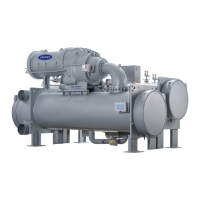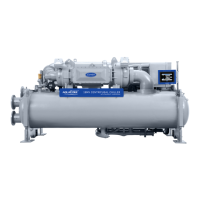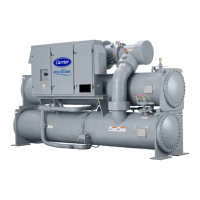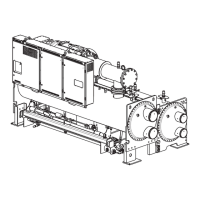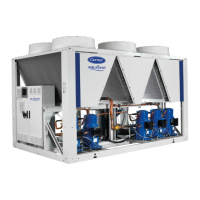77
Estimated Maximum Load Conditions:
44 F (6.7 C) LCL
54 F (12.2 C) ECL
42 F (5.6 C) Suction Temperature
98 F (36.7 C) Condensing Temperature
Calculate Maximum Load
— To calculate the minimum load
points, use data from the sales requisition or estimate the
chilled liquid delta T based on a percentage of full load where
the HGBP should be energized. The minimum condensing
pressure can be based on the entering condenser liquid tem-
perature available at minimum load. Use the proper saturated
pressure and temperature for R-134a.
Suction Temperature:
43 F (6.1 C) = 38 psig (262 kPa) saturated
refrigerant pressure (R-134a)
Condensing Temperature:
70 F (21.1 C) = 71 psig (490 kPa) saturated
refrigerant pressure (R-134a)
Minimum Load HGBP DELTA T1 (at 15% load):
0.15 x (54-44) = 1.5º F (0.15 x (12.2 – 6.7) = 0.8º C
Minimum Load HGBP DELTA P1:
71 – 38 = 33 psid (490 – 262 = 228 kPad)
Determine HGBP DELTA T2/HGBP DELTA P1:
Set HGBP DELTA T2 equal to 0.1º F larger than HGBP
DELTA T1:
HGBP DELTA T2 = HGBP DELTA T1 + 0.1 = 1.6º F
(0.8 + 0.06 = 0.9º C)
Set HGBP DELTA P2 to a large value to create a steep slope
(see Fig. 22 and 23) HGBP DELTA P2 = 200 psid (1379 kPa).
If the hot gas bypass is energized too soon or too late:
If variable evaporator flow is applied, changes to
DELTA T1 proportional to the reduction in evaporator liquid
flow rate are required.
The differential pressure (P) and temperature (T) can be
monitored during chiller operation by viewing ACTIVE
DELTA P and ACTIVE DELTA T (HEAT_EX screen). Com-
paring HGBP DELTA T to ACTIVE DELTA T will determine
when the HGBP valve will open. The smaller the difference
between the HGBP DELTA T and the ACTIVE DELTA T
values, the closer to stall prevention or the point at which the
HGBP will open.
If the ACTIVE DELTA T is less than the HGBP DELTA T,
the HGBP valve will be activated. The HGBP will be deacti-
vated once the ACTIVE DELTA T is greater than the HGBP
DELTA T plus the HGBP DEADBAND if the ACTIVE DELTA
P is less than HGBP DELTA P1.
When the HGBP option is set to 2, HGBP ON DELTA
SPEED should be based on the estimated minimum load con-
ditions as was HGBP DELTA T1 in the example above. HGBP
OFF DELTA SPEED functions similar to a deadband above
the temperature entered in HGBP ON DELTA T as shown in
Fig. 33.
MODIFY EQUIPMENT CONFIGURATION IF NECES-
SARY — The EQUIPMENT SERVICE table has screens to
select, view, or modify parameters. Carrier’s certified drawings
have the configuration values required for the jobsite. Modify
these values only if requested.
SERVICE Screen Modifications
— Change the values on
these screens according to specific job data. See the certified
drawings for the correct values. Modifications can include:
• Chilled liquid reset
• Entering chilled liquid control (Enable/Disable)
• 4 to 20 mA demand limit
• Auto restart option (Enable/Disable)
• Remote contact option (Enable/Disable)
Owner-Modified CCN Tables
— The following EQUIP-
MENT CONFIGURATION screens are described for reference
only.
OCCDEFCS — The OCCDEFCS screen contains the Local
and CCN time schedules, which can be modified here or on the
SCHEDULE screen as described previously.
HOLIDAYS — From the HOLIDAYS screen, the days of the
year that holidays are in effect can be configured. See the
holiday paragraphs in the Controls section for more details.
BRODEF — The BRODEF screen defines the start and end of
daylight savings time. By default this feature is enabled. Enter
the dates for the start and end of daylight savings if required
for your location. Note that for DAY OF WEEK, 1 represents
Monday. START WEEK and STOP WEEK refer to the instance
of the selected DAY OF WEEK during the selected START
MONTH and year. To disable the feature, change START
ADVANCE and STOP BACK times to 0 (minutes). In the
BRODEF table the user may also identify a chiller as the time
broadcaster for a CCN network with TIME BROADCAST
ENABLE. There should be only one device on a CCN network
which is designated as the time broadcaster.
ALARM ROUTING (Fig. 49) — ALARM ROUTING is in
the table SERVICE/EQUIPMENT CONFIGURATION/
NET_OPT under the heading Alarm Configuration. ALARM
ROUTING consists of an 8-bit binary number. Only bits 1, 2,
and 4 (counting from the left) are used. The bits can be set by
any device which can access and change configuration tables.
If any of these 3 bits is set to 1, the ICVC will broadcast any
alarms which occur.
Bit 1: Indicates that the alarm should be read and processed by
a front end device, such as a ComfortWORKS
®
device.
Bit 2: Indicates that the alarm should be read and processed by
a TeLINK or Autodial Gateway module.
HGBP ENERGIZED
TOO SOON
HGBP ENERGIZED
TOO LATE
Decrease HGBP DELTA T1
and HGBP DELTA T2 by
0.5° F (0.3° C)
Increase HGBP DETLA T1
and HGBP DELTA T2 by
0.5° F (0.3° C)
1
1
0
1
0
0
0
0
Alarm Printer Interface Module
Autodial Gateway
Local Building Supervisors(s)
or ComfortWORKS
unused
ALARM CONTROL
ALARM ROUTING
Alarm routing settings should be left at default settings and only be
changed by technicians trained in CCN. These settings determine
which CCN system elements will receive and process alarms sent
by the ICVC. Input for the decision consists of eight digits, each of
which can be set to either 0 or 1. Setting a digit to 1 specifies that
alarms will be sent to the system element that corresponds to that
digit. Setting all digits to 0 disables alarm processing. Digits in
this decision correspond to CCN system elements in the following
manner:
NOTE: If your CCN does not contain ComfortWORKS
®
con-
trols or a Building Supervisor or Autodial Gateway to serve as an
alarm acknowledger, set all digits in this decision to 0 in order to
prevent unnecessary activity on the CCN Communication Bus.
Allowable Entries 00000000 to 11111111
0 = Disabled, 1 = Enabled
Default Value 10000000
Fig. 49 — Alarm Control and Alarm Routing
a19-1627

